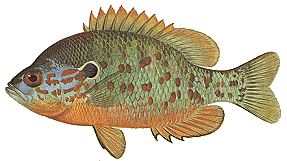
Classification
Kingdom: Animalia
Animals in the kingdom Animalia are also referred to as
Metazoans. Some characteristics of the kingdom Animalia are:
multicellular, eukaryotic heterotrophs digest in an internal
cavity, lack of ridged cell walls, develop from embryos (SREI
2013).
Phylum: Chordata
The organismal traits that represent the Phylum Chordata include:
bilateral symmetry, segmented body/segmented muscles, single nerve
cord connecting to the brain, protruding tail, complete digestive
system, and an endoskeleton consisting of either bones or cartilage
(Myers, 2001)
Subphylum: Vertebrata
Traits that specify the subphylum Vertebrata include the following;
vertebral column, perforated pharynx, muscles attached to
endoskeleton, digestive system, ventral heart, and consist of the
general body plan including appendages, trunk and head (Myers,
2001).
Superclass: Osteichthyes
Traits of the super class Osteichthyes consist of the following:
fins in pairs made of rays and spines, different scale types,
external fertilization, marine and fresh water species, no external
ears, no eye lids, skeleton made of bone, and a two chambered heart
(Prakash, 2003)
Class: Actinopterygii
‘ray-finned fishes’ (Jonna, 2004)
Subclass: Neopterygii
The word Neoterygii means “new fins” (Online Encyclopedia,2010)
Infraclass: Teleostei
The word Teleostei is an infraclass of fishes including all the
ordinary boney fishes as distinguished from the ganoids (Online
Encyclopedia, 2010)
Superorder: Acanthopterygii
The superorder Acanthoptergii is the fishes having fins with
sharp bony rays (Online Encyclopedia, 2010)
Order: Perciforms
Traits that most Perciformes have in
common are spine on the front
parts of the dorsal and anal fins; pelvic fines made up of one spine
and five rays, or supporting rods; rough scales; and the presence of
a lateral line (Net Industries, 2013).
Suborder: Percoidei
Family: Centrarchidae
Any fish that is part of the sunfish family (Online Encyclopedia,
2010)
Genus: Lepomis
Species: Lepomis humilis
"Orange-spotted Sunfish"
(Nelson et al. 2004)
